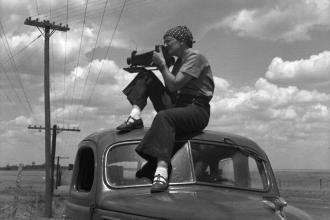Poverty and racial marginalization, internment camps, and life during wartime — these are among the most famous themes documentary photographer Dorothea Lange chronicled in her groundbreaking 20th century career.
From her iconic images of migrant farmworkers in the 1930s to her photographs showing Japanese Americans in government-enforced “relocation centers” during the 1940s, Lange wasn’t afraid of shining light on America’s darker realities. As the country continues to grapple with similar struggles, the time feels right to revisit Lange’s work in a new online archive that debuted earlier this month from the Oakland Museum of California.
Drew Johnson, the museum’s curator of photography and visual culture, says that even in Lange’s own lifetime, her work was constantly being rediscovered as the same social issues persisted.
“Lange gave a wonderful oral history to UC Berkeley before she passed,” Johnson recalls of the artist, who died in 1965. “She said, ‘Someone showed me photos of migrant farmworkers they had just taken. They look just like what I made in the ’30s.'”
Erin O’Toole, the Baker Street Foundation associate curator of photography at the San Francisco Museum of Modern Art, calls Lange “one of the most important and best-known photographers ever to make her home in Bay Area — and that’s saying a lot.” She names Carleton Watkins and Lange’s peers Ansel Adams and Edward Weston as other notable Bay Area photographers, but says that “what’s unique is her archive and all that material stayed in the Bay Area. That is not the case with Adams or Weston and many other Bay Area photographers.”
The archive has been in the possession of OMCA since Lange’s death, but it was recently digitized thanks to a grant from the Henry Luce Foundation.
Lange was a longtime Bay Area resident and operated a portrait studio in San Francisco from 1918 until the early 1930s, during her first marriage to painter Maynard Dixon. In 1935, she married UC Berkeley economics professor Paul Schuster Taylor and lived with him in Berkeley until her death from esophageal cancer at age 70.
While living in Berkeley, Lange embarked on the work for the United States Resettlement Administration and Farm Security Administration that produced her best-known images.
Johnson, who has worked with the Lange collection at OMCA for more than 30 years, was initially mentored by the museum’s founding curator of photography, Therese Heyman. Heyman not only knew the collection intimately, she had also known Lange and Taylor in their lifetimes. One of the reasons OMCA was chosen as the recipient of the collection was because the couple “liked the idea it was going to be local,” says Johnson. “… The collection wasn’t just going to be sequestered for scholars and historians, but available to public.”
The two other major collections of Lange’s work reside at the Library of Congress and National Archives.
The Dorothea Lange Archive at the Oakland Museum of California: The permanent collection is free to view at dorothealange.museumca.org.
